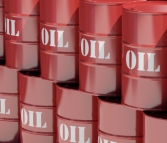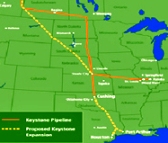US industry sees self-sufficiency for natural gas, but not crude oil – survey
 The US can bank on plentiful domestic natural gas, but should expect a continued reliance on foreign oil, according to oil and gas decision-makers who participated in a new Deloitte survey released on Tuesday.
The US can bank on plentiful domestic natural gas, but should expect a continued reliance on foreign oil, according to oil and gas decision-makers who participated in a new Deloitte survey released on Tuesday.
Three-quarters of the survey respondents think the US is already natural gas self-sufficient, or will be within 10 years.
When it comes to oil, however, survey respondents are far less optimistic about the ability to meet American demand with domestic supplies: 54% say the US will never be completely oil self-sufficient, and only 26% say oil self-sufficiency is achievable in the next 10 years.
Deloitte said it believes that if the question of oil self-sufficiency had been expanded to include all of North America, the results would likely have been different.
“Given North America’s remarkable success with unconventional oil – both tight oil in places like North Dakota and oil sands in Canada – something closely resembling self-sufficiency is arguably within reach,” said Peter Robertson, an independent senior advisor to Deloitte and former vice chairman of Chevron.
“When you combine unconventional oil supplies with the recently established increase in shale gas reserves, you could have the makings of a true energy renaissance.”
 Deloitte conducted the survey in late October and canvassed 250 oil and gas professionals from a decision-making demographic: Respondents were 48 years old on average and had an average of 20 years’ experience in the industry. All had college or graduate degrees and earned over $100,000 per year.
Deloitte conducted the survey in late October and canvassed 250 oil and gas professionals from a decision-making demographic: Respondents were 48 years old on average and had an average of 20 years’ experience in the industry. All had college or graduate degrees and earned over $100,000 per year.
“It’s not surprising that oil and gas decision-makers are enthusiastic about the role of natural gas in our national energy future, given burgeoning supplies, America’s comparatively low cost of extraction, and its relative cleanliness,” said John England, vice chairman of Deloitte and leader of Deloitte’s oil and gas practice.
“What is surprising is that natural gas is a fuel source that we were aggressively preparing to import at high world prices just a few years ago.”
Tale of two prices
Looking at 2013, oil and gas professionals see natural gas prices remaining quite low – with 40% predicting prices less than $3/MMBtu, and a large majority (86%) predicting Henry Hub prices under $4/MMBtu. More specifically:
• 4% see prices below $2/MMBtu.
• 36% see prices between $2 and $2.99/MMBtu.
• 46% see prices between $3 and $3.99/MMBtu.
• 14% see prices above $4/MMBtu.
Crude oil prices, on the other hand, are expected to remain relatively strong next year. The majority of respondents (57%) think the average cost of a barrel of West Texas Intermediate oil in 2013 will be between $80 and $99/bbl. More specifically:
• 2% see prices below $80/bbl.
• 17% see prices at $80 to $89/bbl.
• 40% see prices at $90 to$99/bbl
• 28% see prices at $100 to $109/bbl.
• 7 % see prices at $110 to $119/bbl.
• 5% see prices above $120/bbl.
Shale plays on right track
Regarding natural gas regulations, almost half (49%) think regulations related to hydraulic fracturing are “just right” or “evolving, but on the right track” – but a minority (39%) still believe there is “too much regulation.” Just 5% say there is “too little regulation” and 7 say they are “unsure.”
Meanwhile, a clear majority (63%) of oil and gas professionals supports regulations requiring producers to disclose the contents of their hydraulic fracturing fluids – with only 24% in opposition. About 1 in 10 (13%) are “unsure.”
 Looking at the issue of shale gas resource estimates, a majority (51%) of oil and gas insiders believe that current industry estimates for the amount of recoverable resources are “pretty much on target” – with 23% saying they are “somewhat overestimated” and the exact same amount saying they are “somewhat underestimated.”
Looking at the issue of shale gas resource estimates, a majority (51%) of oil and gas insiders believe that current industry estimates for the amount of recoverable resources are “pretty much on target” – with 23% saying they are “somewhat overestimated” and the exact same amount saying they are “somewhat underestimated.”
Extremely few think shale resources are “very overestimated” or “very underestimated” – 1% and 2%, respectively.
“It seems clear that oil and gas professionals believe America has a veritable bounty of shale gas resources,” said Roger Ihne, principal for Deloitte Consulting, serving the oil and gas sector. “In simple terms, over 95% think the current industry estimates are accurate or not far off.”
LNG exports, stable prices expected
With the large resource base of natural gas in the US, industry professionals foresee continued low prices and new market opportunities.
Most survey respondents think that the abundance of shale gas will lead to liquefied natural gas (LNG) exports. A large majority (72%) expect that LNG export terminals will eventually receive government approval – with 36% believing this approval will occur before 2014 and the exact same percent expecting approval after 2014.
Similarly, the survey found that even with exports of LNG, most oil and gas decision-makers don’t see a meaningful increase in domestic natural gas prices. A strong majority (93%) sees either no price increase or a slight change in price. In contrast, less than 1 in 10 (7%) see a significant price increase.
“Given the reserve estimates and current supplies, it only makes sense that natural gas producers are keen to develop new uses for their gas," said Ihne. "One possible option that stood out among survey respondents was use as a transportation fuel."
When asked to identify the best alternative transportation fuels to gasoline and diesel, survey respondents clearly preferred natural gas – with 67% seeing products like compressed natural gas (CNG) as the most promising option to refined oil products, far ahead of other top choices like electricity (11%) and biofuels (8%).
Clarity on Keystone XL, M&A and capital spending The survey also looked at a host of other pressing issues facing oil and gas companies today. Most notably, it found that:
The survey also looked at a host of other pressing issues facing oil and gas companies today. Most notably, it found that:
• A large majority (78%) of respondents expect that the Keystone XL pipeline will eventually receive government approval – with 42%expecting approval in 2013 and 36% expecting approval in 2014 or later.
• Most oil and gas professionals expect increased capital spending in 2013: More than half (59%) predict “much more” or “somewhat more” spending. About 1 in 3 (35%) expect spending to remain the same, and only 6% expect it to decrease.
• A majority of oil and gas decision-makers expect mergers and acquisitions to remain steady next year: 53% expect “much more” or “a little more” activity and 42% think it will “remain about the same.” Only 5% expect less activity.
• Well over half (65%) of all respondents see an increase in exploration and production in the Gulf of Mexico, while 26% expect activity levels to remain the same. Less than 1 in 10 respondents (9%) expect a decrease.
• Oil and gas professionals see a steady outlook for refining, with a majority expecting profitability in 2013 to stay the same (42%) or increase somewhat (37%).






Comments